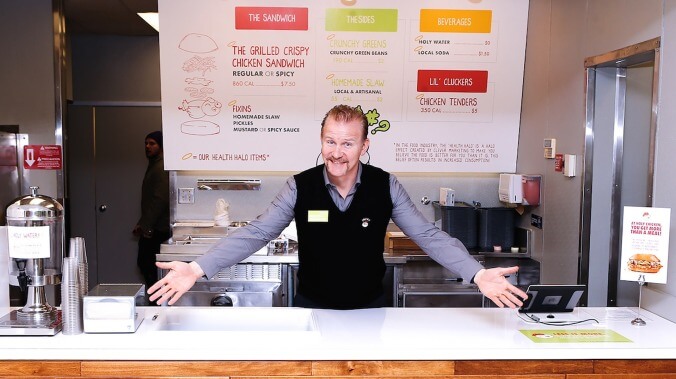Super Size Me 2 isn’t much better for you than the chicken sandwiches it condemns


Have you heard the good word about Popeyes’ chicken sandwich, the king of fried fowl on bread? Over this past few weeks, Popeyes-sandwich-mania seemed ubiquitous, becoming the great escapist concern of our otherwise depressing media cycle. It was tested, think-pieced, tweeted about, and praised by foodies and ordinary folks alike. It was hyped like fast-food menu items had rarely been before. And, as of this writing, it is effectively unavailable—which, depending on one’s level of cynicism, is either a simple question of demand far exceeding supply, or another shrewd move in a marketing blitz that has stretched the limits of free publicity.
Not that the success of the sandwich was something no one could have predicted. Chicken, which once made up only a fraction of beef-heavy American diets, has in recent years risen to become the most popular meat in the country; just last year, Chick-fil-A, the kings of the game, became the third largest restaurant chain in the country in terms of sales figures, bypassing much larger chains like Burger King and Taco Bell. The chicken sandwich, in other words, is having a moment.
So, at least in one respect, Morgan Spurlock’s documentary Super Size Me 2: Holy Chicken! could not wish for better timing; it is, in large part, about the business of making and selling chicken sandwiches. In most other respects, however, it feels like a relic. The film’s ignominious history is just one part of it: It was shot in 2016 and sold for millions after a premiere at the 2017 Toronto International Film Festival, only to be dropped and indefinitely shelved after Spurlock admitted to a long history of sexual misconduct. This preemptory, self-managed downfall overshadows Holy Chicken!, which, like most of Spurlock’s documentaries, depends on the filmmaker’s ingratiating personality; without it, all that’s left are foregone conclusions and easily Googleable facts. But even without that baggage, one can’t help but feel that Spurlock’s glib, superficial approach—with its man-on-the-street interviews, cutesy musical cues, and disingenuous mock-naïveté—has long since slid into irrelevance.
Nominally, Holy Chicken! is meant to serve as a sequel to Super Size Me, the popular 2004 documentary that put Spurlock’s name on the map—and it does, in some of its more memorable moments, touch on the ways in which fast-food chains have revamped their image since the days of the 42-oz. fountain drink. (Most of its more interesting observations have to do with design, from the lettering on Chipotle wrappers to use of wood grain in Wendy’s restaurant interiors.) Like that earlier film, in which the filmmaker spent 30 days eating McDonald’s for every meal—and discovered, quelle surprise, that consuming something like 5,000 calories a day without an Olympian fitness regimen could have deleterious effects on one’s health—it revolves around a stunt. Spurlock, you see, takes it upon himself to open his own post-ironic pop-up fried-chicken-sandwich joint in Columbus, Ohio, “the test market capital of America,” and intends to cover the whole process, from the hatchery to the deep fryer.
To help him raise his own chickens, he enlists a veteran poultry farmer from Alabama; to design the product, he hires a bevy of “food trend experts” and “brand strategy consultants”; to tie it all together, he asks for our suspended disbelief. Spurlock’s post-Super-Size-Me projects (including the likes of Where In The World Is Osama Bin Laden? and Mansome) have given his film work a deserved reputation for vacuousness, but the truth is that he is very much in his element when addressing superficialities—say, the marketing gimmickry of attaching meaningless labels like “cage-free” and “hormone-free” to chicken meat. (Broiler chickens, i.e. the ones farmed for their meat, are never raised in cages, and using growth hormones on them is illegal, not to mention pointless.) The restaurant itself (also called Holy Chicken) is a mildly amusing, sub-Banksy stunt, concocted with the help of a couple of ironically detached millennial marketing gurus. It comes complete with a customer pen that meets the USDA requirements of “free range” and employees who draw fake grill marks on the meat in full view of the clientele.
But Spurlock appears to have bitten off more than he can chew, which becomes obvious whenever the subject turns to the handful of corporations that control 99% of the American poultry industry, collectively dubbed “Big Chicken.” He expresses what seems like sincere sympathy for the chicken farmers: exploited by a corporate system that controls both their supply and their distribution; cheated out of a steady income by a “tournament” pricing formula that pits them against one other, with payments determined by each farmer’s place on a local scoreboard. Not that the implications or origins of this system are ever addressed in a meaningful way. Nor would Spurlock ever dare suggest that capitalism might be the root problem; in the worst tradition of nominally liberal advocacy, he remains an awkwardly “apolitical” nodder. His ultimate goal is to teach people to be better consumers, which is anything but a challenge to the status quo. (Say what you will about Michael Moore, whose shtick undoubtedly inspired Spurlock’s own, but even his worst documentaries have a clear political and social conscience.) Which is to say that Spurlock’s documentary turns out to be the exact thing it is meant to expose: an unfulfilling product passed off as something that’s good for you.